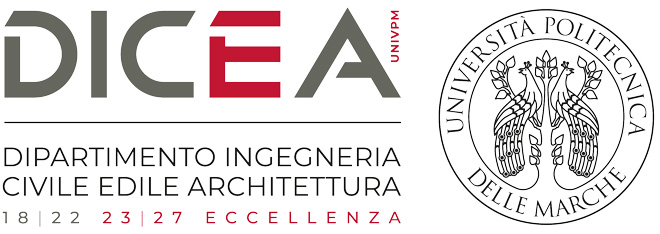The research area DIGITAL & HERITAGE (D&He) encompasses two research groups working in complementary and integrated fields: Digital Cultural Heritage (DISTORI) and Geomatics Applications & Processing (GAP). DISTORI includes the disciplinary sectors of Drawing, History of Architecture, and Architectural Restoration, while the GAP research group belongs to the Geomatics discipline.
DIGITAL&HERITAGE took shape in a more organized way in the early 2000s, with the aim of working on historical architectural, archaeological, and territorial heritage, while introducing the necessary multidisciplinary skills for this purpose. The critical thinking of the area is structured around the previous cultural and scientific vision of Professors Fausto Pugnaloni, Paolo Taus, Gabriele Fangi, Fabio Mariano, and Gabriele Milelli, who laid its roots and know-how.
Building upon this solid background, new activities are now moving towards experimentation and technological innovation.
The research area DIGITAL&HERITAGE carries out educational and research activities. The educational activities include courses in Architectural Drawing and Representation, Architectural Surveying, Architectural Restoration, History of Architecture, Topography, Information Systems for Construction, Digital Documentation for the Use of Historical and Archaeological Heritage, Geomatics Engineering, Geomatics, and Geomatics for Land Management in undergraduate and graduate programs in Civil and Architectural Engineering, Civil and Environmental Engineering, Environmental Engineering, Construction and Land Management Techniques, as well as in the Master’s Degree Program in Forestry, Soils, and Landscape Sciences (FORESPA).
In addition to collaborating with the industry for applied research activities in support of national and international institutions and organizations, the area has projects under Erasmus or funded by the European Union through competitive calls or by the Ministry of Foreign Affairs and International Cooperation (MAECI) both in Asia (Vietnam and Jordan) and South America (Peru, Brazil, Argentina).
DIGITAL&HERITAGE is committed to study historical, architectural, territorial, and environmental heritage through a dynamic and continuous process that enriches knowledge of history, culture, and diversity in the fields of architecture and landscape/territory. This aims to provide a clearer understanding of historical dynamics, cultural influences, as well as changes that have occurred on the territory over time.
DIGITAL&HERITAGE is dedicated to preserving and protecting cultural, architectural, archaeological, landscape, and territorial heritage through scientific digitalization and critical knowledge of the cultural heritage system, aiming to achieve a Digital Twin, as a faithful reproduction of the original. This process provides essential information for conservation, maintenance, and restoration, thereby ensuring the safeguarding of heritage for future generations. Digital mapping, as well as digital orthoimages and remote sensing data, are also necessary for the study of the territory. At different scales and levels of detail, they provide the basis for GIS, while 3D information provides models that are virtual replicas at an urban and territorial scale; finally, CityGML provides a realistic representation of the territory through digital terrain models.
DIGITAL&HERITAGE is committed to promoting awareness, conservation, education, community involvement, and economic and cultural enhancement of cultural and natural resources through the development of Digital User Experiences based on new interaction technologies that leverage Virtual, Augmented, and Mixed Reality, and by experimenting with Artificial Intelligence (AI) algorithms for analysis, interpretation, segmentation, and classification of artificial and natural elements.
Conserving and enhancing cultural and natural heritage contributes to the social development of communities, serving as a resource for cultural tourism, education, cultural awareness, and economic opportunities. It also aids in monitoring and safeguarding a fragile territory, which is a source of wealth and cultural resource.
DIGITAL&HERITAGE places cultural heritage, both tangible and intangible, at the center of its research activities.
Studies and projects are focused on the knowledge, conservation, enhancement, and management of urban and architectural heritage, with particular reference to historical-documentary, material-constructional, and digital aspects. The spectrum of DIGITAL&HERITAGE competences includes historical research as a knowledge base, digital cultural heritage, drawing, and surveying as graphic and infographic mediation, 3D modeling, the development of ICT tools to improve and broaden access to cultural assets (virtual and augmented reality restitutions and navigations), the analysis of physical consistency, and monitoring of the conservation status of historical buildings. Additionally, it involves designing preventive and planned conservation strategies for existing constructions at different scales, studying and prototyping innovative forms of data representation and management in the context of HBIM (Historic Building Information Modeling).
Furthermore, the environment and territory constitute another pillar of DIGITAL&HERITAGE, where research activities are directed towards the natural environment, landscape, and cultural heritage at various scales. Competences in this area include remote sensing, digital cartography, aerial and close-range digital photogrammetry, GNSS (Global Navigation Satellite System), Lidar, and SLAM (Simultaneous Localization and Mapping), which are integrated into data collection for transitioning from GIS to CityGML to (H)BIM. Mapping environmental phenomena (earthquakes, land use, change detection, precision farming) covers a wide range of data acquisition and processing technologies in the era of Big Data, seeking to overcome any gaps with innovative solutions. Crowd-sourcing methodologies, experimented in various application cases, help in understanding the management of public spaces and providing different valorizations in the perspective of so-called “Senseable Space.” The use of AI (Artificial Intelligence) further enhances the collaboration and cross-fertilization with other research areas, developing solutions across different fields and intersecting distinct but complementary know-how.
DIGITAL&HERITAGE carries out its research activities through the application and development of innovative and constantly evolving methodologies, tools, and technologies in national and international contexts, characterized by interdisciplinarity and cross-mediality.
In recent years, numerous research agreements with public entities and institutions, both national and international, have contributed to the expansion and diversification of competences, offering new challenges and opportunities. Some exemplary collaborations of DIGITAL&HERITAGE include partnerships with ICOM (International Council of Museums), SAPAB Marche, Institute of Intangible Heritage, Marche Culture Foundation, Marche National Museum Complex, National Gallery of Marche in Urbino, and National Archaeological Museum of Ancona, as well as collaborations with the Central Apennines Basin District Authority (ABDAC), ICOMOS, CIPA, and SIFET.
